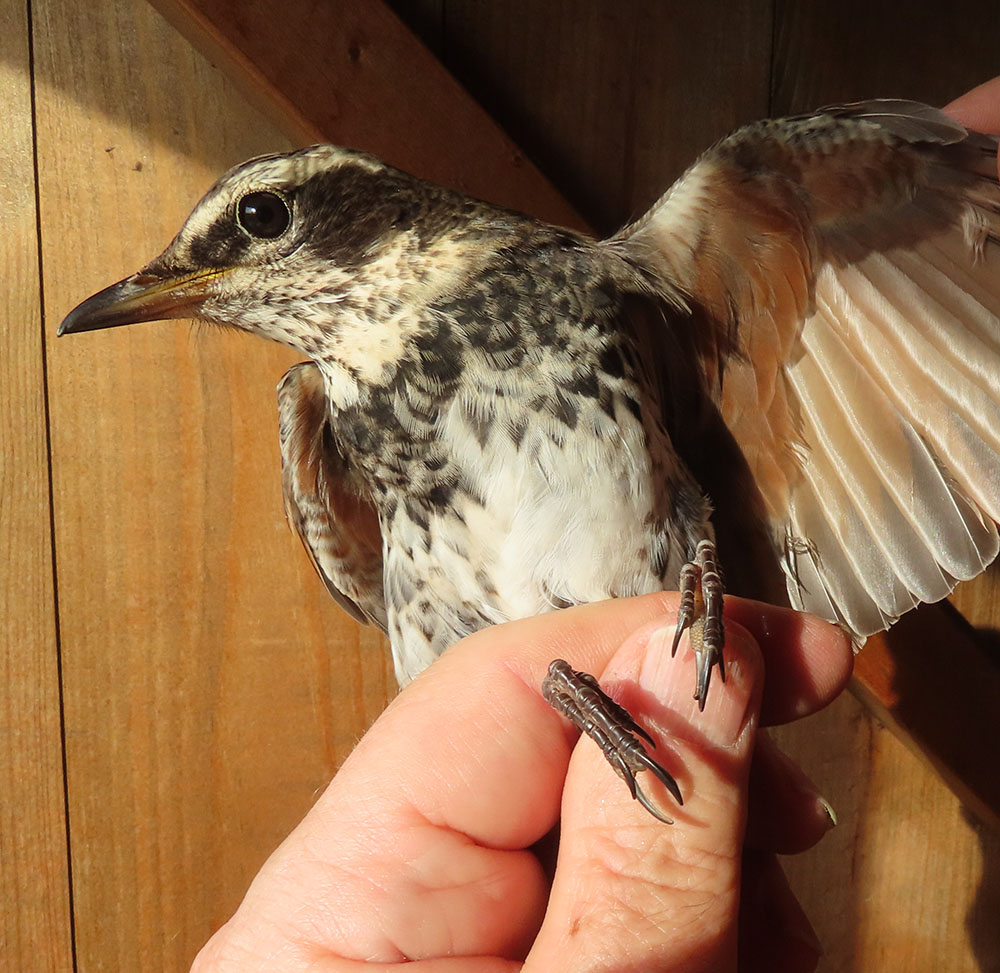Friday 21 October was unusually calm for Pitcox Farm, just inland from Dunbar in East Lothian, where the wind blows more often than not. It was also overcast and dry, so I thought I would take the rare opportunity of the ideal conditions and put up my mistnets for a ringing session.
As I got the nets up, there were small parties Redwings and the occasional Brambling passing overhead, plus a good number of Goldcrests in the trees and bushes, so migrants were clearly on the move. By mid-afternoon, I'd caught almost 70 birds, although six Goldcrests and two Blackcaps were the only migrants among a selection of the local residents.
At approximately 3 pm, I set out on another round of checking the nets. Four short (6-m) nets were sited in a narrow shelterbelt of low trees and berry-bearing shrubs running up a field margin. Having extracted a couple of European Greenfinches, a Tree Sparrow and a Eurasian Blackcap from the first three, I came to the last one. In it was a solitary bird, suspended quietly in the bottom shelf. I took one look at it and, with unusual restraint, said to myself that it looked interesting.
Obviously a thrush, it had pale, dark-spotted underparts, a densely marked breast-band, rusty-red underwing and edgings to the flight feathers and – most strikingly – a whopping great eye-stripe. It was clearly a Dusky Thrush!. I popped it in a bag and headed back to my ringing hut (the potting shed in our garden).

The Dusky Thrush was trapped and ringed following a couple of days of huge winter thrush arrivals into Britain (Liz Fraser).
When I got there, I found my wife, Liz, and a neighbour sitting on the garden bench having a blather. I said nothing (probably because I was lost for words), but went into the hut and bolted the door behind me – this was one bird that I did not want to escape. Liz could tell something was up.
Looking through the shed window as I took the bird out of the bag, with similarly commendable restraint but more than a hint of disbelief and trying to associate it with a species with which she was familiar, she asked: "What is that? It's got an eye-stripe like a tchagra!" She took a couple of quick phone shots through the window for the record before I let her in to see the bird close-up, locking the door again!
Birds caught for ringing are held only as long as is necessary to process (measurements and so on) and ring them. During this short time the bird, likely a first-winter female, was photographed in the hand and then released in an adjacent woodland. It flew off strongly, giving a softish, disyllabic call like a muffled Fieldfare.
After giving the bird, wherever it was, time to settle down, we went looking for it to see if it would be a viable twitch for other birders, but with no luck. For a number of reasons, not least that it was now getting late in the day and that it was on a busy working farm, it was reluctantly decided not to put word out at the time. The local recorder was, however, contacted and the sighting put on BirdGuides as being at an undisclosed site in Lothian to alert local birders to the fact that it had turned up in their area.
Following discussion with the landowner, a safe and unintrusive plan for viewing was drawn up and the news would be released if the bird reappeared. Sadly, it was not seen on Saturday, nor was there any sign over the next couple of days despite many hours searching in potential places, including the area where we had released it and the original spot where it had been caught. Four days later I'm still looking (you never know ... ).

Mike's find represents the first Dusky Thrush for mainland Scotland, with the previous four Scottish records all in Shetland (Liz Fraser).
Breeding in the Siberian taiga and wintering in South-East Asia, Dusky Thrush is a quality rarity to see in Britain. Despite this status, it is not the regionally rarest species to have occurred at Pitcox. During a spell of warm, southerly airflow in May 2006, I found Scotland's first Iberian Chiffchaff here (first heard from the front door as I was putting the bin out; see Birdwatch 167).
With all respect to the fair-weather Phylloscopus, however, the Dusky is the most exciting bird we've seen here, with its very classy looks and an air of eastern mystery and adventure (well, I thought so).
Whatever, it seems beyond miraculous that a Dusky Thrush should have travelled so far and then popped into a little mistnet parked in some scruffy bushes at the side of a big field a couple of hundred metres from my house. I mean, what are the chances?!


